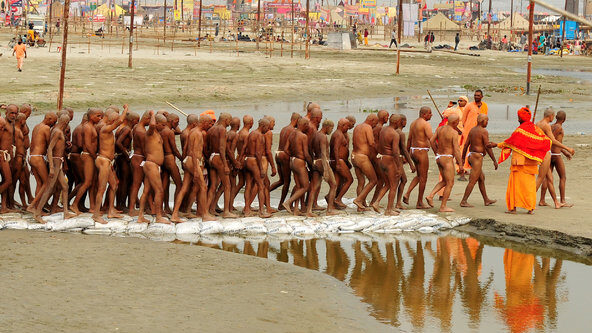About
The Kumbh Mela is the world’s largest mass gathering, where tens of millions congregate at one of four holy sites in India during a several week-long festival. The government builds an ephemeral city — replete with roads, sanitation, and power — in which religious groups and small business provide food, shelter, sermons, and entertainment for the visiting pilgrims. In 2013, Harvard University sent a multi-disciplinary research team of faculty and students with backgrounds in theology, urban planning, public health, and business to study the world’s largest mass gathering.
Why was this study done?
The political will and commitment to making the Mela a success is unprecedented, yet the staggering crowds that come to it repeatedly overwhelm healthcare systems. The 30-120 second window for doctor-patient interaction, as the data in the study reveals, is far from the ideal that the Mela authorities had aspired to.
The size of this dataset will allow the authorities to examine several seminal issues surrounding healthcare delivery: prescription practice, resource allocation, epidemiology, and patient behavior at the sector hospitals in the Mela. Our analysis will hopefully influence planning and resource allocation for future Melas. Furthermore, having successfully demonstrated that it is indeed possible to collect such large quantities of data in this chaotic environment, we hope to work with the National Disaster Management Authority of India to consider piloting digital data collection in future mass gatherings in India.
Designing and Implementing Sophisticated Digital Health Systems
Our team designed and deployed one of the first cloud-based syndromic surveillance systems in the world. We returned to the Kumbh Mela in 2015 to replace all paper-based records at the health clinics with an entirely digital system, illustrating the centrality of sound design-thinking practices in implementing digital public health tools. The tool we used to log data is called “EMcounter” – it was originally developed by emergency medicine residents at NewYork-Presbyterian Hospital (NYP) in 2006 to “count” the medical emergencies that presented to casualty wards of hospitals in India that were moving away from traditional one room receiving rooms to more sophisticated emergency departments staffed by trained emergency physicians.
After its initial successful run at Sundaram Medical Foundation in Chennai, in 2007, EMcounter stayed dormant for a few years until a mobile tablet-based version was tested in South Sudan in 2012. EMcounter now had the capacity to collect data off-line on mobile devices, and could also analyze raw data in real time, as soon as it was uploaded. In other words, we needed several iPads to digitize the records at the sector hospitals, and mobile hotspots to guarantee generous internet availability to the data collectors. Both easily acquirable. Indian companies rent iPads, and mobile hotspots are an inexpensive investment.
What we needed was the official nod to collect this data, and an army of field staff to digitize the patient records. The National Disaster Management Authority of India provided the former and good Kumbh Mela karma the latter. Namita introduced us to Nutan Maurya, who had already been working with the other Harvard teams. As early as December, Nutan had lined up students from Allahabad’s Sam Higginbottom Institute of Agriculture Technology and Sciences. The Agriculture Institute (as it was formerly known) offers India’s oldest two-year Masters in Public Health. The MPH students were eager, sincere, and ready to roll. Senior specialists from NDMA, Naghma Firdaus, helped us identify a contact person in the Allahabad Medical College – Dr. Shraddha Dwivedi, also superintendent of Allahabad’s largest public hospital, Swaroop Rani Nehra Hospital. Dr. Shraddha Dwivedi who extended this team her enthusiastic and whole hearted support, made available a steady stream of rotating medical interns to augment this team. FXB Team 1: Dr. Gregg Greenough, Dr. Pooja Agarwal, and Neil Murthy laid the foundation for the successful implementation of this project during their stay at the Mela in January.
In the Press

“Tracking India’s Deadly Flu Outbreak in Real Time”
PBS, October 28, 2015

“Can Big Data From Epic Indian Pilgrimage Help Save Lives?”
The New York Times, February 8, 2013
Publications
Applying Human-Centered Design Principles to Digital Syndromic Surveillance at a Mass Gathering in India: Viewpoint
Shaikh A, Bhatia A, Yadav G, Hora S, Won C, Shankar M, Heerboth A, Vemulapalli P, Navalkar P, Oswal K, Heaton C, Saunik S, Khanna T, Balsari S
J Med Internet Res 2022;24(1). 10, January 2022.
Using mobile technology to optimize disease surveillance and healthcare delivery at mass gatherings: a case study from India’s Kumbh Mela
Dhruv S. Kazi, P. Gregg Greenough, Rishi Madhok, Aaron Heerboth, Ahmed Shaikh, Jennifer Leaning, Satchit Balsari
Journal of Public Health, Volume 39, Issue 3, September 2017.
A retrospective analysis of hypertension screening at a mass gathering in India: implications for non-communicable disease control strategies
S Balsari, P Vemulapalli, M Gofine, K Oswal, R Merchant, S Saunik, G Greenough & T Khanna
J Hum Hypertens 31, 750–753. 20, July 2017.
Public health aspects of the world’s largest mass gathering: The 2013 Kumbh Mela in Allahabad, India
Satchit Balsari, S., P. Gregg Greenough, Dhruv S. Kazi. et al.
J Public Health Pol 37, 411–427. 08, September 2016.
Water, Sanitation, and Hygiene at the World’s Largest Mass Gathering
Vortmann, M., Balsari, S., Holman, S.R. et al.
Curr Infect Dis Rep 17, 5. 18, March 2015